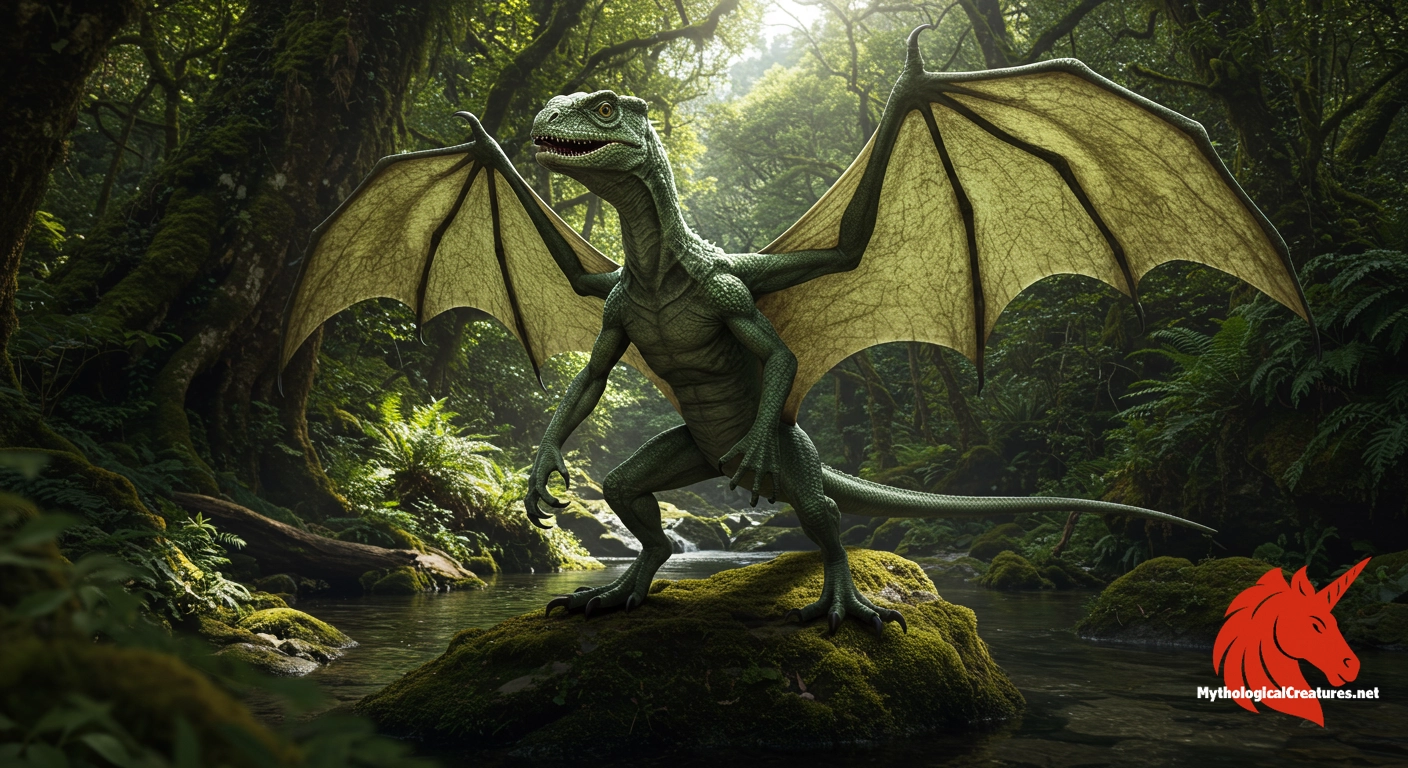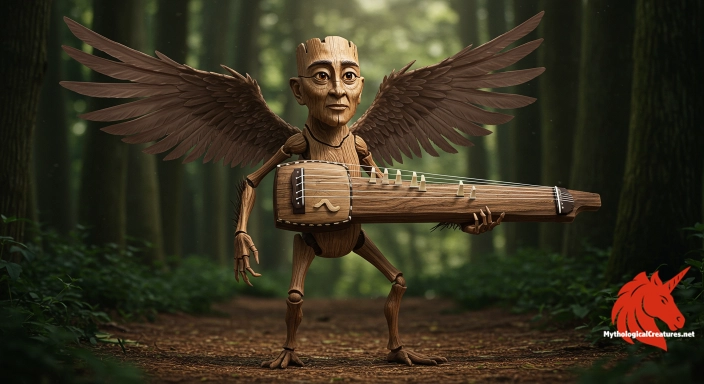Piuchén: The Piuchén is a vampiric shapeshifting creature from Mapuche and Chilote mythology in Chile.

Piuchén
Piuchén - Represents a feared supernatural force and serves as a cautionary symbol of the dangers lurking in the night
Origins & First Encounters
Emerging from the fertile soil of Chilean legend, the Piuchén is a mysterious and fearsome entity that has captivated the collective imagination of both Mapuche and Chilote communities for centuries. Its name, rooted in the indigenous term for 'dry people', hints at symbolic ties to aridity, transformation, and the ephemeral nature of life. The creature occupies a liminal space between the natural and the supernatural, challenging clear boundaries by blending human, reptilian, and avian features. Deeply embedded within oral tradition, its earliest attestations are intertwined with ritual and cautionary tales meant to explain the inexplicable moments in the cycle of everyday life. This enigmatic figure was not only a harbinger of doom but also a mirror reflecting humanity’s fears and fascinations with forces beyond mortal control. Its evolution over time mirrors the shifts in the cultural and ecological landscapes of Chile, adapting as communities reinterpreted their relationship with nature. The Piuchén’s dual capacity to both terrify and intrigue has cemented its role as a potent symbol of the unknown. As a timeless archetype, its allure lies in the interplay between beauty, danger, and the transformative power of myth. The enduring legend of the Piuchén is a testament to the intricate tapestry of indigenous belief systems interlaced with the impermanence and mystery of life.
Source Texts & Tale Variants
The earliest mentions of the Piuchén are interwoven with the rich oral traditions of the Mapuche, where tales of its nocturnal exploits passed from one generation to the next with a blend of awe and trepidation. Colonial chroniclers encountered these stories and recorded fragments that hinted at a creature both monstrous and otherworldly. Over the centuries, local bards and elders embellished these initial accounts, intertwining them with the daily realities of life in a landscape filled with both beauty and peril. A diversity of story variants emerged, some depicting the Piuchén as a cursed soul whilst others portraying it as a nature spirit whose sole purpose was to maintain cosmic balance. In certain narratives, its blood-sucking nature is particularly emphasised, often symbolically linked to the draining of life and resources in times of hardship. Other versions of the legend present a more ambiguous character—one that transitioned between animal forms and even mimicked human traits. Folk performances and night-time rituals in various villages lent further credence to these accounts, ensuring the preservation and continual reinterpretation of its story. The creative dynamism inherent in indigenous storytelling means that each recounting carries its own nuances and embellishments. As a result, the myth of the Piuchén continues to be a living tradition, open to reinterpretation by those who seek to understand the mysteries it represents.
Form & Powers
The Piuchén is commonly envisioned as an unsettling amalgam of distinct creatures, seamlessly merging reptilian traits with the eerie elegance of winged beasts. Its primary form is often described as a large, lizard-like body outfitted with vast, membranous bat wings that enable it to glide silently under moonlit skies. The creature’s skin appears mottled, its scales shifting subtly in colour, perhaps as a natural adaptation to the changing light of dusk and dawn. Many accounts detail a pair of luminous eyes that burn with an otherworldly glow, contributing to the creature’s intimidating visage. A set of slender, razor-like fangs and a forked tongue reinforce its fearsome reputation as a predator of both flesh and spirit. Intriguingly, some renditions hint at vestigial human features—a muted resemblance that blurs the lines between man and monster. The overall physique exudes both agility and a haunting grace, a combination that allows it to vanish as quickly as it appears. Its vocal emissions, ranging from an eerie whistle to a chilling hiss, serve as auditory harbingers of its approach. Variations in size are noted across different legends, with some communities recounting encounters with a diminutive version and others warning of a colossal apparition that dominates the night sky.
Regional Faces
The portrayal of the Piuchén varies significantly across Chile, reflecting the diverse ecological and cultural landscapes of the region. In the highland territories where the Mapuche reside, the creature is predominantly depicted as a serpentine being with the ability to slither through the dry, rugged terrain. Coastal narratives, particularly within the Chilote tradition, accentuate its piscine and avian characteristics, suggesting an intrinsic connection with both land and sea. Local adaptations of the myth emphasise its shapeshifting powers, with some communities recounting stories of the Piuchén assuming the guise of a common animal to deceive unwary passers-by. These regional differences are further underscored by alternative names and subtle shifts in description, each echoing the specific fears and environmental realities of the area. In some rural areas, the myth serves as both a cautionary tale and a ritualistic element employed during seasonal celebrations. The creature’s presence is integrated into local folklore, occasionally serving as an omen or a symbol of natural retribution. Cultural rituals and protective amulets dedicated to warding off its influence illustrate the practical impact of its legend. Such regional adaptations ensure that the Piuchén remains a dynamic and multifaceted figure, reflective of the local ethos and the natural world’s capriciousness.
Cultural Parallels
The multifaceted nature of the Piuchén invites a host of fascinating comparisons with other mythological entities from around the globe. Its blood-sucking traits and nocturnal predations draw clear parallels to the vampiric figures prevalent in Eastern and European traditions, where the consumption of life force is a recurrent theme. The creature’s inherent ability to transform between various animal forms is reminiscent of shape-shifters found in both Asian folktales and Native American legends, highlighting a universal human fascination with metamorphosis. In Latin America, the Piuchén shares intriguing similarities with the more contemporary legend of the Chupacabra, both serving as supernatural explainers for unexplained misfortunes. Other cultural narratives, such as those involving serpentine dragons or hybrid demonic entities, offer additional layers of comparative framework that underscore its complex symbolism. The blending of human and animal characteristics in its depictions echoes themes found in a wide array of mythic archetypes. Its narrative functions as both a cautionary tale against transgression and as an embodiment of nature’s inscrutable power, much like various trickster figures across different traditions. Such cross-cultural connections emphasise the universality of the archetype, where fear of the unknown and fascination with transformation intersect. In these ways, the Piuchén not only stands as a distinct legend in Chilean lore but also as part of a broader tapestry of mythic figures that traverse continental boundaries.
Legacy & Modern Evolution
Through the centuries, the image of the Piuchén has evolved from a terrifying spectre of the night into a layered symbol reflecting the complexities of cultural identity and human interaction with the natural world. Its early depictions, which centred exclusively on its fearsome attributes, have gradually given way to more nuanced portrayals that highlight its ambivalence and transformative power. Modern interpretations in literature, film, and visual arts often present the creature as a metaphor for societal change and the enduring tension between modernity and tradition. In contemporary narratives, the Piuchén is sometimes reimagined as a guardian of lost knowledge or as a victim of a cursed fate, thus inviting deeper reflection on themes of fate, honour, and retribution. This shift is partly a response to global cultural exchanges that encourage a re-evaluation of local myths within a wider context of shared human experiences. Annual festivals and cultural exhibitions in parts of Chile now celebrate its legendary status, drawing interest from both locals and tourists alike. Scholars and enthusiasts continue to probe its multifaceted history, ensuring that the lore surrounding the creature remains a vibrant subject of academic and artistic inquiry. Its depiction today, far from a static relic, is continually reinterpreted in a dialogue between the past and the present. Ultimately, the legacy of the Piuchén is a reflection of the community’s enduring resilience and their capacity to find meaning in the mysterious realms that lie at the margins of human existence.
Interesting Fact
An intriguing aspect of the Piuchén is its composite nature, which appears to blend indigenous myth with observations of local fauna, such as the vampire bat, highlighting how natural phenomena can inspire fantastical legends.
Quick Creature Info
Origin:
Features:
Our Mythic Legendary Rating:

Also Sometimes Known As:
Habitat:
Supernatural Powers:
Physical Attributes:
Abilities:
Behavior:
Lore:
Related Creatures, Tales or Lore
- CChupacabra
- SStrigoi
- VVampire Bat
References
Discover Another Mythical Legend You May Not Have Heard Of?
Uncover the mysteries of ancient folklore and expand your knowledge of legendary beings from cultures around the world.
Dare to Meet the Koto-furunushi....
Mythical Disclaimer: The images and data on this site are derived from various historical and literary sources, but we have found that many myths often have multiple versions and interpretations across references, sometimes contradictory. As a result, these creature depictions are artistic interpretations—imaginative blends of folklore, legend, and a dash of AI guesswork. Because creature descriptions vary widely, our illustrations and accompanying information represent our best effort to honor mythology while bridging creative gaps. Enjoy these interpretations—just remember, we've done our best to respect the stories and validate available data, but in the realm of mythology, details often shift, imagination leads the way, and nothing is ever set in stone!
Curated by the Mythological Creatures Team (rev. May 2025)
